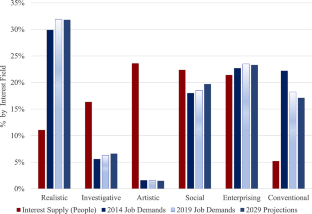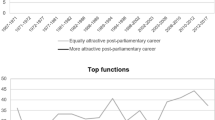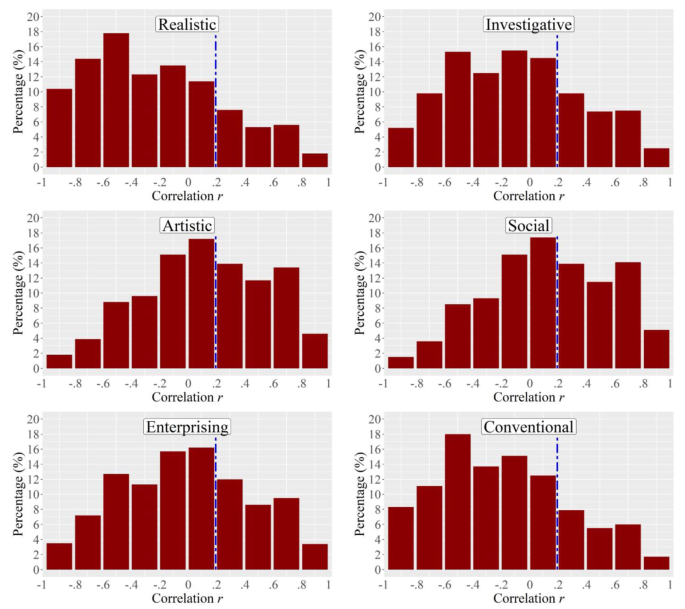Abstract
Vocational interest assessments are widely used to determine which jobs might be a good fit for people. However, showing a good fit to particular jobs does not necessarily mean that those jobs are available. In this respect, little is known about the alignment between people’s vocational interests and national labor demands. The current study used a national dataset comprising 1.21 million United States residents to investigate this issue empirically. Results revealed three major findings. First, around two-thirds of people were most interested in people-oriented jobs (i.e., artistic, social, or enterprising interests), with the remaining one-third being most interested in things-oriented jobs (i.e., realistic, investigative, or conventional interests). Second, the distribution of people’s interests did not align with U.S. job demands in 2014, 2019, and 2029 (projections), revealing large gaps between interest supply and demand. Notably, the most popular interest among people (artistic) was the least demanded among jobs, whereas the least popular interest among people (conventional) was highly demanded among jobs. Third, interest gaps were generally larger at lower education levels, indicating that higher education can provide more opportunities to achieve interest fit at work. We integrate these findings to discuss implications for individuals, organizations, and career guidance practitioners aimed at better coordinating people’s interests with available jobs to promote individual career success and national workforce readiness.


Similar content being viewed by others
Notes
The year 2010 was chosen for Census data because it approximates the middle of the interval (2005–2014) in which interest data was collected. In addition, the complete Census is only conducted every ten years.
Job zone 1 occupations require little-to-no experience; and in the current study, these jobs were matched to participants who had less than a high school degree. Job zone 2 occupations require a high school diploma, which was matched to participants with a high school diploma. Job zone 3 occupations typically require some college or a community college degree; in the current study, this included participants who had obtained a trade/technical school degree, an Associate’s degree, some college, or a community college degree. Job zone 4 occupations typically require a 4-year college degree, which was matched to those with a Bachelor’s degree. Finally, job zone 5 occupations require a graduate degree; this included participants with a Master’s, Doctoral, or Professional degree.
Note that the average degree of fit between employed participants’ and their reported occupation (r = .20) was greater than the average degree of fit between all participants and all occupations (r = − .02) because individuals tend to self-select into occupations based on their interests.
Fig. 2 Examining interest supply and demand using profile correlations. Note. Total N = 1,208,465. To estimate these distributions, each participant’s RIASEC interest profile was correlated with each O*NET occupation. Then, occupations were organized based on their RIASEC high-point code, such that the red bars display the distributions of participants showing different levels of profile-based fit with all of the occupations in each RIASEC category. The vertical, dotted blue line represents the average degree of fit between employed participants in the sample and their occupation (r = .20)
References
Arntz, M., Gregory, T., & Zierahn, U. (2016). The risk of automation for jobs in OECD countries: A comparative analysis. OECD Social Employment and Migration Working Papers. OECD Publishing.
Asuyama, Y. (2021). Determinants of job interestingness: Comparison of Japan and other high-income countries. Labour Economics, 73, 102082. https://doi.org/10.1016/j.labeco.2021.102082.
Batalova, J., & Cumoletti, M. (2021, May 17). Middle Eastern and North African immigrants in the United States. Migrationpolicy.Org. https://www.migrationpolicy.org/article/middle-eastern-and-north-african-immigrants-united-states-2016.
Batalova, J., & Hanna, M. (2021, April 7). Indian immigrants in the United States. Migrationpolicy.Org. https://www.migrationpolicy.org/article/indian-immigrants-united-states-2019.
Bayl-Smith, P., & Griffin, B. (2017). Age discrimination within a P‐E fit paradigm: Maintaining fit with an active work style. Journal of Occupational and Organizational Psychology, 90(3), 306–328. https://doi.org/10.1111/joop.12173.
Bubany, S. T., & Hansen, J. I. C. (2011). Birth cohort change in the vocational interests of female and male college students. Journal of Vocational Behavior, 78(1), 59–67. https://doi.org/10.1016/j.jvb.2010.08.002.
Bureau of Labor Statistics (2021). Labor force statistics from the current population survey. Retrieved August 3, 2021, from https://www.bls.gov/web/empsit/cpseea36.htm.
Bureau of Labor Statistics (2015). Occupational employment projections 2014–2024. Monthly Labor Review Retrieved from: https://www.bls.gov/opub/mlr/2015/article/occupational-employment-projections-to-2024.htm.
Carlsson, M., & Eriksson, S. (2019). Age discrimination in hiring decisions: Evidence from a field experiment in the labor market. Labour Economics, 59, 173–183. https://doi.org/10.1016/j.labeco.2019.03.002.
Colato, J., Dubina, K., Kim, J. L., & Rieley, M. (2022). Projections overview and highlights, 2021–31, monthly labor review. Retrieved from https://www.bls.gov/opub/mlr/2022/article/projections-overview-and-highlights-2021-31.htm.
Croft, A., Schmader, T., & Block, K. (2015). An underexamined inequality: Cultural and psychological barriers to men’s engagement with communal roles. Personality and Social Psychology Review, 19(4), 343–370. https://doi.org/10.1177/1088868314564789.
del Río, C., & Alonso-Villar, O. (2015). The evolution of occupational segregation in the United States, 1940–2010: Gains and losses of gender—Race/ethnicity groups. Demography, 52, 967–988.
Deville, J. C., Särndal, C. E., & Sautory, O. (1993). Generalized raking procedures in survey sampling. Journal of the American Statistical Association, 88(423), 1013i1020. https://doi.org/10.1080/01621459.1993.10476369.
Donnay, D. A. C., Morris, M. L., Schaubhut, N. A., & Thompson, R. C. (2005). Strong interest inventory manual: Research, development, and strategies for interpretation. CPP.
Eagly, A. (2021). Hidden in plain sight: The inconsistent gender gaps in stem and leadership. Psychological Inquiry, 32(2), 89–95. https://doi.org/10.1080/1047840X.2021.1930764.
Felten, E. W., Raj, M., & Seamans, R. (2023). Occupational heterogeneity in exposure to generative AI. Available at SSRN: https://doi.org/10.2139/ssrn.4414065.
Frey, C. B., & Osborne, M. A. (2017). The future of employment: How susceptible are jobs to computerisation? Technological Forecasting and Social Change, 114, 254–280.
Gagné, M., Parker, S. K., Griffin, M. A., Dunlop, P. D., Knight, C., Klonek, F. E., & Parent-Rocheleau, X. (2022). Understanding and shaping the future of work with self-determination theory. Nature Reviews Psychology, 1(7), 378–392.
Giffi, C., Wellener, P., Dollar, B., Manolian, H. A., Monck, L., & Moutray, C. (2018). Deloitte and the Manufacturing Institute skills gap and future of work study. Deloitte Development, LLC. Downloaded from https://documents.deloitte.com/insights/2018DeloitteSkillsGapFoWManufacturing.
Gottfredson, G. D., Holland, J. L., & Gottfredson, L. S. (1975). The relation of vocational aspirations and assessments to employment reality. Journal of Vocational Behavior, 7(1), 135–148. https://doi.org/10.1016/0001-8791(75)90040-8.
Grant, A. M., & Shandell, M. S. (2022). Social motivation at work: The organizational psychology of effort for, against, and with others. Annual Review of Psychology, 73, 301–326. https://doi.org/10.1146/annurev-psych-060321-033406.
Hambrick, D. Z., Burgoyne, A. L., & Oswald, F. L. (2019). The role of interests in the development of expertise: A multifactorial perspective. In C. D. Nye & J. Rounds (Eds.), Vocational interests in the workplace: Rethinking behavior at work (pp. 280–299). Routledge. https://doi.org/10.4324/9781315678924-14.
Handel, M. J. (2003). Skills mismatch in the labor market. Annual Review of Sociology, 29(1), 135–165. https://doi.org/10.1146/annurev.soc.29.010202.100030.
Hanna, A., & Rounds, J. (2020). How accurate are interest inventories? A quantitative review of career choice hit rates. Psychological Bulletin, 146(9), 765–796. https://doi.org/10.1037/bul0000269.
Harackiewicz, J. M., Canning, E. A., Tibbetts, Y., Priniski, S. J., & Hyde, J. S. (2016). Closing achievement gaps with a utility-value intervention: Disentangling race and social class. Journal of Personality and Social Psychology, 111(5), 745–765. https://doi.org/10.1037/pspp0000075.
Hirschi, A. (2018). The fourth industrial revolution: Issues and implications for career research and practice. The Career Development Quarterly, 66(3), 192–204. https://doi.org/10.1002/cdq.12142.
Hoff, K. A., Briley, D. A., Wee, C. J. M., & Rounds, J. (2018). Normative changes in interests from adolescence to adulthood: A meta-analysis of longitudinal studies. Psychological Bulletin, 144(4), 426–451. https://doi.org/10.1037/bul0000140.
Hoff, K. A., Song, Q. C., Wee, C. J. M., Phan, W. M. J., & Rounds, J. (2020). Interest fit and job satisfaction: A systematic review and meta-analysis. Journal of Vocational Behavior. https://doi.org/10.1016/j.jvb.2020.103503.
Hoff, K. A., Chu, C., Einarsdóttir, S., Briley, D. A., Hanna, A., & Rounds, J. (2021a). Adolescent vocational interests predict early career success: Two 12-year longitudinal studies. Applied Psychology: An International Review. https://doi.org/10.1111/apps.12311.
Hoff, K., Van Egdom, D., Napolitano, C., Hanna, A., & Rounds, J. (2021b). Dream jobs and employment realities: How adolescents’ career aspirations compare to labor demands and automation risks. Journal of Career Assessment, 10690727211026183. https://doi.org/10.31234/osf.io/hrjzt.
Hoff, K. A., Granillo-Velasquez, K. E., Hanna, A., Morris, M., Nelson, H. S., & Oswald, F. L. (2024). Interested and employed? A national study of gender differences in basic interests and employment. Journal of Vocational Behavior, 148, 103942.
Holland, J. L. (1997). Making vocational choices: A theory of vocational personalities and work environments. Psychological Assessment Resources.
Hsu, N., Badura, K. L., Newman, D. A., & Speach, M. E. P. (2021). Gender, masculinity, and femininity: A meta-analytic review of gender differences in agency and communion. Psychological Bulletin, 147(10), 987–1011. https://doi.org/10.1037/bul0000343.
Johnston, W. B., & Packer, A. E. (1987). Workforce 2000: Work and workers for the 21st century. Hudson Institute.
Jones, K. S., Newman, D. A., Su, R., & Rounds, J. (2020). Black-white differences in vocational interests: Meta-analysis and boundary conditions. Journal of Business and Psychology, 1–19. https://doi.org/10.1007/s10869-020-09693-5.
Kirkendall, C. D., Nye, C., Rounds, J., Drasgow, F., Chernyshenko, O., & Stark, S. (2020). Adaptive vocational interest diagnostic: Informing and improving the job assignment process. Military Psychology, 32(1), 91–100. https://doi.org/10.1080/08995605.2019.1652480.
Leuty, M. E., & Hansen, J. I. C. (2014). Teasing apart the relations between age, birth cohort, and vocational interests. Journal of Counseling Psychology, 61(2), 289. https://doi.org/10.1037/a0035341.
Low, K. S. D., Yoon, M., Roberts, B. W., & Rounds, J. (2005). The stability of interests from early adolescence to middle adulthood: A quantitative review of longitudinal studies. Psychological Bulletin, 131(5), 713–737. https://doi.org/10.1037/0033-2909.131.5.713.
Lumley, T. (2020). Survey Package (4.1-1) [R Programming Package]. CRAN Package. https://cran.r-project.org/web/packages/survey/survey.pdf.
Marshall, W., & Craig, R. (2019). The dangers of skills-gap skepticism. The Hill. https://thehill.com/opinion/finance/436350-the-dangers-of-skills-gapskepticism.
McClain, M. C., & Reardon, R. C. (2015). The US workforce from 1960 to 2010: A RIASEC view. The Professional Counselor, 5(1), 1. https://doi.org/10.15241/rcr.5.1.1.
McCloy, R. A., Rottinghaus, P. J., Park, C. J., Feller, R., & Bloom, T. (2020). YouScience: Mitigating the skills gap by addressing the gender imbalance in high-demand careers. Industrial and Organizational Psychology, 13, 426–441. https://doi.org/10.1017/iop.2020.73.
McIntyre, M. M. (2022). Judging what others enjoy: Desirability and observability of interests. Journal of Career Assessment, 30(3), 557–572. https://doi.org/10.1177/10690727211055862.
Metz, A. J., Fouad, N., & Ihle-Helledy, K. (2009). Career aspirations and expectations of college students: Demographic and labor market comparisons. Journal of Career Assessment, 17(2), 155–171. https://doi.org/10.1177/1069072708328862.
Morris, M. L. (2016). Vocational interests in the United States: Sex, age, ethnicity, and year effects. Journal of Counseling Psychology, 63, 604–615. https://doi.org/10.1037/cou0000164.
National Center for Education Statistics (2014). Degrees conferred by postsecondary institutions, by level of degree and sex of student: Selected years, 1869–70 through 2024–25 (Table 316.10.; Digest of Education Statistics). U.S. Department of Education https://nces.ed.gov/programs/digest/d14/tables/dt14_318.10.asp.
National Center for O*NET Development (2008). Procedures for O*NET job zone assignment. O*NET Resource Center. https://www.onetcenter.org/dl_files/JobZoneProcedure.pdf.
Nye, C. D., Su, R., Rounds, J., & Drasgow, F. (2017). Interest congruence and performance: Revisiting recent meta-analytic findings. Journal of Vocational Behavior, 98, 138–151. https://doi.org/10.1016/j.jvb.2016.11.002.
Nye, C. D., Prasad, J., & Rounds, J. (2021). The effects of vocational interests on motivation, satisfaction, and academic performance: Test of a mediated model. Journal of Vocational Behavior, 127, 103583. https://doi.org/10.1016/j.jvb.2021.103583.
Office of Management and Budget (2018). Standard Occupational Classification manual. U.S. Department of Labor National O*NET Resource Center. https://www.bls.gov/soc/2018/soc_2018_manual.pdf.
Oswald, F. L., & Ferstl, K. L. (1999). Linking a structure of vocational interests to Gottfredson’s (1986) occupational aptitude patterns map. Journal of Vocational Behavior, 54, 214–231. https://doi.org/10.1006/jvbe.1998.1647.
Oswald, F. L., Behrend, T. S., & Foster, L. L. (Eds.). (2019). Workforce readiness and the future of work. Routledge. https://doi.org/10.4324/9781351210485.
Owens, A. (2010). Neighborhoods and schools as competing and reinforcing contexts for educational attainment. Sociology of Education, 83(4), 287–311. https://doi.org/10.1177/0038040710383519.
Piesch, H., Gaspard, H., Parrisius, C., Wille, E., & Nagengast, B. (2020). How can a relevance intervention in math support students’ career choices? Journal of Applied Developmental Psychology, 71, 101–185. https://doi.org/10.1016/j.appdev.2020.101185.
Prediger, D. J. (1982). Dimensions underlying Holland’s hexagon: Missing link between interests and occupations? Journal of Vocational Behavior, 21, 259–287. https://doi.org/10.1016/0001-8791(82)90036-7.
Reeve, C. L., & Hakel, M. D. (2000). Toward an understanding of adult intellectual development: Investigating within-individual convergence of interest and knowledge profiles. Journal of Applied Psychology, 85(6), 897–908. https://doi.org/10.1037/0021-9010.85.6.897.
Renninger, K. A., & Hidi, S. E. (2020). To level the playing field, develop interest. Policy Insights from the Behavioral and Brain Sciences, 7(1), 10–18. https://doi.org/10.1177/2372732219864705.
Rounds, J., & Su, R. (2014). The nature and power of interests. Current Directions in Psychological Science, 23(2), 98–103. https://doi.org/10.1177/0963721414522812.
Rounds, J., Armstrong, P., Liao, H., Lewis, P., & Rivkin, D. (2008). Second generation occupational interest profiles for the O*NET system: Summary. National Center for O*NET Development.
Rounds, J., Hoff, K., Chu, C., Lewis, P., & Gregory, C. (2018). O* NET Interest Profiler Short Form paper-and pencil version: Evaluation of self-scoring and psychometric characteristics. Raleigh, NC: National Center for O* NET Development.
Rounds, J., Hoff, K. A., & Lewis, P. (2021). O*NET® interest profiler Manual. U.S. Department of Labor National O*NET Resource Center. https://www.onetcenter.org/reports/IP_Manual.html.
Schneider, B., Chen, I., Bradford, L., & Bartz, K. (2022). Intervention initiatives to raise young people’s interest and participation in STEM. Frontiers in Psychology, 13, 960327. https://doi.org/10.3389/fpsyg.2022.960327.
Stewart-Williams, S., & Halsey, L. G. (2021). Men, women and STEM: Why the differences and what should be done? European Journal of Personality, 35(1), 3–39.
Su, R., & Rounds, J. (2015). All STEM fields are not created equal: People and things interests explain gender disparities across STEM fields. Frontiers in Psychology, 6. https://doi.org/10.3389/fpsyg.2015.00189.
Su, R., Rounds, J., & Armstrong, P. I. (2009). Men and things, women and people: A meta-analysis of sex differences in interests. Psychological Bulletin, 135, 859–884. https://doi.org/10.1037/a0017364.
Su, R., Stoll, G., & Rounds, J. (2019a). The nature of interests: Toward a unifying theory of trait-state interest dynamics. In C. D. Nye, & J. Rounds (Eds.), Vocational interests: Rethinking their role in understanding workplace behavior and practice. Routledge. SIOP organizational frontiers serieshttps://doi.org/10.4324/9781315678924-2.
Tims, M., Bakker, A. B., & Derks, D. (2013). The impact of job crafting on job demands, job resources, and well- being. Journal of Occupational Health Psychology, 18(2), 230–240. https://doi.org/10.1037/a0032141.
Van Iddekinge, C. H., Putka, D. J., & Campbell, J. P. (2011a). Reconsidering vocational interests for personnel selection: The validity of an interest-based selection test in relation to job knowledge, job performance, and continuance intentions. Journal of Applied Psychology, 96(1), 13–33. https://doi.org/10.1037/a0021193.
Van Iddekinge, C. H., Roth, P. L., Putka, D. J., & Lanivich, S. E. (2011b). Are you interested? A meta-analysis of relations between vocational interests and employee performance and turnover. Journal of Applied Psychology, 96(6), 1167–1194. https://doi.org/10.1037/a0024343.
Women’s Bureau (2022). Employment and earnings by occupation. Department of Labor: U.S. https://www.dol.gov/agencies/wb/data/occupations.
Funding
The authors declare that they have no conflict of interest.
Author information
Authors and Affiliations
Corresponding author
Additional information
Publisher’s Note
Springer Nature remains neutral with regard to jurisdictional claims in published maps and institutional affiliations.
Additional supplementary materials may be found here by searching on article title https://osf.io/collections/jbp/discover
Electronic Supplementary Material
Below is the link to the electronic supplementary material.
Data Transparency Appendix
Data Transparency Appendix
The vocational interest dataset reported in this manuscript was included in one published study (Morris, 2016), as well as one submitted study under review (Hoff et al., 2024). The table below displays the variables used in the current study (Hoff et al., 2024) and how they differ from the other studies. To summarize, the current study has a unique focus on the popularity of RIASEC interest profiles which have not yet been analyzed using this dataset. In addition, we collected and aggregated an extensive amount of information about the interest profiles of jobs in the U.S. labor market using data from the Bureau of Labor Statistics and O*NET (which is also unique to this manuscript). More generally, no results from the current manuscript overlap with any other manuscript, with exception of basic descriptive information about the data collection procedure and measures. MS1 was published in 2016 and focused on demographic differences in mean interest scores, but does not contain any information about the popularity of interest profiles. MS3 focuses on gender differences in basic interest scales, which are distinct from the RIASEC scales used in the current study.
Note that in the table below, the O*NET Occupational Interest Profiles and Bureau of Labor Statistics Employment Data come from publicly available datasets that were linked and aggregated for use in the current study. All other variables are from the proprietary vocational interest dataset owned by the The Myers Briggs Company.
Description of sample variables used in previous, current, and planned work
Variables in Complete Dataset | MS 1 (STATUS = Pub) | MS 2 (STATUS = Current) | MS 3 (STATUS = Under review) |
|---|---|---|---|
Bureau of Labor Statistics Employment Data | X | ||
O*NET Occupational Interest Profiles | X | ||
RIASEC Interest Profiles | X | ||
RIASEC Interest Mean scores | X | ||
Basic interests | X | ||
Current Occupation | X | ||
Gender | X | X | X |
Ethnicity | X | X | X |
Education | X | X | |
Age | X | X | X |
Rights and permissions
Springer Nature or its licensor (e.g. a society or other partner) holds exclusive rights to this article under a publishing agreement with the author(s) or other rightsholder(s); author self-archiving of the accepted manuscript version of this article is solely governed by the terms of such publishing agreement and applicable law.
About this article
Cite this article
Hoff, K.A., Granillo-Velasquez, K.E., Hanna, A. et al. Interest Gaps in the Labor Market: Comparing People’s Vocational Interests with National Job Demands. J Bus Psychol (2024). https://doi.org/10.1007/s10869-024-09945-8
Accepted:
Published:
DOI: https://doi.org/10.1007/s10869-024-09945-8





